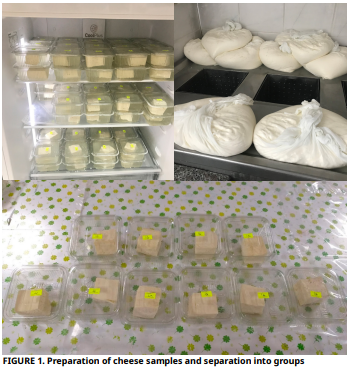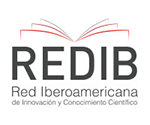Efecto del sorbato de potasio, la nisina y la lisozima, individualmente y en combinación, sobre la calidad del queso blanco encurtido durante el almacenamiento
Resumen
Este estudio se realizó para determinar los efectos del sorbato de potasio, la nisina y la lisozima en la calidad microbiológica, química y sensorial de quesos blancos encurtidos durante su vida útil. Para ello, el queso blanco Şavak, elaborado experimentalmente con una mezcla de 50 % de leche de oveja y 50 % de leche de vaca, se cortó en lonchas (4×4×4 cm) y se almacenó en salmuera al 16 % con sorbato de potasio (1 g·ml-1), nisina (12,5 mg·l-1) y lisozima (200 mg·l-1), solos o en combinación, a 4°C, durante 90 días. Al final del almacenamiento, se encontraron diferencias estadísticamente significativas entre el grupo de combinación que utilizó sorbato de potasio 1 g·L-1 + nisina 12,5 mg·L-1 y el grupo control en términos de niveles de efecto antimicrobiano sobre coliformes, Enterobacteriaceae, Estreptococos fecales, lipolíticos, proteolíticos y E. coli (P≤0,05). No se encontraron diferencias estadísticamente significativas entre los grupos en términos de evaluación sensorial (P>0,05). Sin embargo, de acuerdo con las puntuaciones numéricas dadas, el grupo 4 (sorbato de potasio 1 g·L-1 + nisina 12,5 mg·L-1) y el grupo 7 (sorbato de potasio 1 g·L-1 + nisina 12,5 mg·L-1 + lisozima 200 mg·L-1) se convirtieron en los dos grupos más apreciados en términos de evaluación sensorial con puntuaciones iguales (95,55). Se concluyó que la combinación de sorbato de potasio 1 g·L-1 + nisina 12,5 mg·L-1, que es un aditivo con el estatus General Reconocido como Seguro y cumple con la legislación para su uso en quesos madurados en salmuera y ofrecidos para la venta, puede usarse de manera segura como un método alternativo al tratamiento térmico para mejorar la calidad de los quesos blancos encurtidos y que contiene datos que pueden formar la base para nuevos estudios para investigar cómo estos aditivos también pueden tener efectos sobre algunas bacterias patógenas.
Descargas
Citas
Mazlum H, Atasever M. Innovations in dairy technology: probiotics in Turkish white cheese production. J. Food Meas. Charact. [Internet]. 2024; 18(10):8577–8589. doi: https://doi.org/p7xh DOI: https://doi.org/10.1007/s11694-024-02826-x
Kamber U. Traditional Anatolian Cheeses. Erzurum (Türkiye): Miki Printing; 2005.
Bilgehan G, Alan S, Akgol M, Incili GK, Oksuztepe G. Şavak taze beyaz peynirlerde Listeria monocytogenes ve Salmonella spp. varliğinin araştirilmasi [Investigation of the presence of Listeria monocytogenes and Salmonella spp. in Savak fresh white cheese]. F.U. Sag. Bil. Vet. Derg. [Internet]. 2021 [cite May 14, 2025]; 35(3):131–135. Turkish. Available in: https://goo.su/Hi1rhKJ
Kalit S, Dolencic Spehar I, Rako A, Bendelja Ljoljic D, Kirdar SS, Tudor Kalit M. An overview: specificities and novelties of the cheeses of the Eastern Mediterranean. Fermentation [Internet]. 2024; 10(8):404. doi: https://doi.org/p7xk DOI: https://doi.org/10.3390/fermentation10080404
European Union. Regulation (EC) No 1333/2008 of the European Parliament and of the Council on food additives. [Internet]. Luxembourg: Official Journal of the European Union. 2008 [cited May 14, 2025]; Available in: https://goo.su/fQayU
Khorshidian N, Khanniri E, Koushki MR, Sohrabvandi S, Yousefi M. An overview of antimicrobial activity of lysozyme and its functionality in cheese. Front. Nutr. [Internet]. 2022; 9:833618. doi: https://goo.su/vZa6D DOI: https://doi.org/10.3389/fnut.2022.833618
Wehr HM, Frank JF, editors. Standard methods for the examination of dairy products. 17th ed. [Internet]. Washington DC (USA): American Public Health Association; 2024. doi: https://doi.org/p7xm
Harrigan WF. Laboratory methods in food microbiology. 3rd ed. London (UK): Academic Press; 1998.
Zhang G, Ferguson M, Blodgett RJ. Aerobic plate count. In: Karen Jinneman, editor. Bacteriological Analytical Manual [Internet]. U.S. Food & Drug Administration (FDA). 2025. [cited May 14, 2025]; Available in: https://goo.su/jXT2
Demir P, Aydemir ME, Alan S, Oksuztepe G. Antimicrobial efficiency of rosemary, thyme and clove essential oils on the preservation of marinated chicken breasts (fillets). Rev. Cient. FCV–LUZ. [Internet]. 2024; 34(2):e34346 doi: https://doi.org/p7xn DOI: https://doi.org/10.52973/rcfcv-e34346
International Organization for Standardization. ISO 21528-2: Microbiology of the food chain–Horizontal method for the detection and enumeration of Enterobacteriaceae–Part 2: Colony–count technique. Geneva (Switzerland): International Organization for Standardization; 2017 [cited May 14, 2025]. Available in: https://goo.su/ZdX4d
Uçak İ, Afreen M. Effect of chitosan coating enriched with peppermint essential oil emulsion on the microbiological quality of fish meatballs. Eurasian J. Food Sci. Technol. [Internet]. 2022 [cited May 14, 2025]; 6(1):60–68. Available in: https://goo.su/Chaa7p
Pechenov P, Stanovov D, Efimov A, Belalov I, Kulikov E, Letarov A. Biodiversity, isolation and sequencing of Lactococcus lactis bacteriophages from dairy industry plants in Russia. Microbiology [Internet]. 2023; 92(6):868–874. doi: https://doi.org/p7xp DOI: https://doi.org/10.1134/S0026261723601823
Mizuochi S, Nelson M, Baylis C, Green B, Jewell K, Monadjemi F, Chen Y, Salfinger Y, Fernandez MC. Matrix extension study: validation of the compact dry EC method for enumeration of Escherichia coli and non–E. coli coliform bacteria in selected foods. J. AOAC Int. [Internet]. 2016; 99(2):451–460. doi: https://doi.org/f8jbr4 DOI: https://doi.org/10.5740/jaoacint.15-0268
International Organization for Standardization. ISO 6888-1: Microbiology of the food chain–Horizontal method for the enumeration of coagulase–positive staphylococci (Staphylococcus aureus and other species–Part 1: Method using Baird–Parker agar medium. Geneva (Switzerland): International Organization for Standardization; 2021 [cited May 14, 2025]. Available in: https://goo.su/MmpX3
Demir P, Baykalir Y, Oksuztepe G. Investigation of the physiochemical and microbiological quality of fruit yoghurt sold in Elazig Province. Eur. J. Agric. Food Sci. [Internet]. 2023; 5(5):75–82. doi: https://doi.org/p7xq DOI: https://doi.org/10.24018/ejfood.2023.5.5.709
Alan S, Akgöl M, Öksüztepe G. Some quality parameters of unpackaged raw milk sold in Elazığ. F.U. Sag. Bil. Vet. Derg. [Internet] 2023 [cited May 14, 2025]; 37(3):209–216. Available in: https://goo.su/W2aY4Pe
Combs JC, Sikora F, Harrison G. Assessing error upon sampling bagged animal feed. J. Regul. Sci. [Internet]. 2024; 12(1):1-33. doi: https://doi.org/p7xr DOI: https://doi.org/10.21423/JRS.REGSCI.121293
Turkish Standards Institute. Determination of fat content in raw milk (TS ISO 2446). Ankara (Türkiye): TSE; 2015.
Macit E, Yücel N, Dertli E. Characterization of the non–starter lactic acid bacteria and yeast microbiota and the chemical and aromatic properties of traditionally produced Turkish white cheese. Braz. J. Microbiol. [Internet]. 2023; 54(3):2227– 2241. doi: https://doi.org/p7xs DOI: https://doi.org/10.1007/s42770-023-01098-9
Hodges CB, Stone BM, Johnson PK, Carter JH III, Sawyers CK, Roby PR, Lindsey HM. Researcher degrees of freedom in statistical software contribute to unreliable results: A comparison of nonparametric analyses conducted in SPSS, SAS, Stata, and R. Behav. Res. Methods. [Internet]. 2023; 55(6):2813–2837. doi: https://doi.org/p7z3 DOI: https://doi.org/10.3758/s13428-022-01932-2
Sumbuloglu K, Sumbuloglu V. Biyoistatistik [Biostatistics]. 15th Edition. Ankara (Türkiye): Hatiboglu Yayınları; 2012. Turkish. 299 p.
Abd–Elaal SF, Alnakip ME, Youssef MZ, Bayoumi MA. Comparison of controlling capabilities of lactobionic acid, nisin, and K–sorbate against dairy–borne Staphylococcus aureus, Escherichia coli, and mold in soft cheese. Open Vet. J. [Internet]. 2024; 14(1):594-603. doi: https://doi.org/p7z6 DOI: https://doi.org/10.5455/OVJ.2024.v14.i1.55
Badem A, Uçar G. The properties of kashar cheese produced with added rennet casein. Eurasian J. Vet. Sci. [Internet]. 2018; 34(4):242-248. doi: https://doi.org/p7z7 DOI: https://doi.org/10.15312/EurasianJVetSci.2018.206
Sinigaglia M, Bevilacqua A, Corbo MR, Pati S, Del Nobile MA. Use of active compounds for prolonging the shelf life of mozzarella cheese. Int. Dairy J. [Internet]. 2008; 18(6):624– 630. doi: https://doi.org/cgb8g8 DOI: https://doi.org/10.1016/j.idairyj.2007.11.022
Demir P, Öksüztepe G, İncilı GK, İlhak Oİ. The use of potassium sorbate in vacuum packaged şavak tulum cheese. Kafkas Univ. Vet. Fak. Derg. [Internet]. 2017; 23(1):23–30. doi: https://doi.org/p7z8 DOI: https://doi.org/10.9775/kvfd.2016.15707
Gharsallaoui A, Oulahal N, Joly C, Degraeve P. Nisin as a food preservative: Part 1: Physicochemical properties, antimicrobial activity, and main uses. Crit. Rev. Food Sci. Nutr. [Internet]. 2016; 56(8):1262–1274. doi: https://doi.org/g82wtp DOI: https://doi.org/10.1080/10408398.2013.763765
Wu T, Jiang Q, Wu D, Hu Y, Chen S, Ding T, Ye X, Liu D, Chen J. What is new in lysozyme research and its application in food industry? A review. Food Chem. [Internet]. 2019; 274:698– 709. doi: https://doi.org/gqwgmn DOI: https://doi.org/10.1016/j.foodchem.2018.09.017
Cotter PD, Ross RP, Hill C. Bacteriocins—a viable alternative to antibiotics?. Nat. Rev. Microbiol. [Internet]. 2013; 11(2):95–105. doi: https://doi.org/gf5mvb DOI: https://doi.org/10.1038/nrmicro2937
Field D, Fernandez de Ullivarri M, Ross RP, Hill C. After a century of nisin research: where are we now? FEMS Microbiol. Rev. [Internet]. 2023; 47(3):1–18. doi: https://doi.org/p72b DOI: https://doi.org/10.1093/femsre/fuad023
Doğruer Y, Gürbüz Ü, Nizamlioğlu M. Effect of potassium sorbate on the chemical and microbiological quality of white cheese. Eurasian J. Vet. Sci. [Internet] .1996 [cited May 14, 2025]; 12(1):109–116. Available in: https://goo.su/7cXok
Parada JL, Chirife J, Magrini RC. Effect of BHA, BHT and potassium sorbate on growth of Staphylococcus aureus in a model system and process cheese. J. Food Prot. [Internet]. 1982; 45(12):1108–1111. doi: https://doi.org/p72c DOI: https://doi.org/10.4315/0362-028X-45.12.1108
Yardımcı BK, Şahin SC, Sever NI, Özek NS. Biochemical effects of sodium benzoate, potassium sorbate and sodium nitrite on food spoilage yeast Saccharomyces cerevisiae. Biologia [Internet]. 2022; 77(2):547–557. doi: https://doi.org/p72d DOI: https://doi.org/10.1007/s11756-021-00964-x
Minj S, Anand S. Whey proteins and its derivatives: Bioactivity, functionality, and current applications. Dairy [Internet]. 2020; 1(3):233–258. doi: https://doi.org/mddn DOI: https://doi.org/10.3390/dairy1030016
Duda–Chodak A, Tarko T, Petka–Poniatowska K. Antimicrobial compounds in food packaging. Int. J. Mol. Sci. [Internet]. 2023; 24(3):2457. doi: https://doi.org/p73t DOI: https://doi.org/10.3390/ijms24032457
Cakmakci S, Dagdemir E, Hayaloglu AA, Gurses M, Gundogdu E. Influence of ripening container on the lactic acid bacteria population in Tulum cheese. World J. Microbiol. Biotechnol. [Internet]. 2008; 24(3):293–299. doi: https://doi.org/fjwx3x DOI: https://doi.org/10.1007/s11274-007-9470-z
Koyuncu N, Uylaser V. Benzoic acid and sorbic acid levels in some dairy products consumed in Türkiye. Asian J. Chem. [Internet] 2009 [cited May 14, 2025]; 21(6):4901–4908. Available in: https://goo.su/zKheajP
Warnock DW, Funke G, Jorgensen JH, Pfaller MA, Landry ML, Carroll KC, Richter SS. Manual of clinical microbiology. 11th ed. Washington DC (USA): ASM Press; 2019.
Çayır Üstündağ H, Yalçın H. Bacteriocins and their use in food products. MAKU J. Health Sci. Inst. [Internet] 2017 [cited May 14, 2025]; 5(1):53–65. doi: https://doi.org/p73v
Khudhir ZS. Evaluation of the antibacterial activity of the brine, nisin solution, and ozonated water against E. coli O157:H7 in the experimentally local produced soft cheese. Iraqi J. Vet. Med. [Internet]. 2021; 45(1):17–21. doi: https://doi.org/p73w DOI: https://doi.org/10.30539/ijvm.v45i1.1035
Soltani S, Hammami R, Cotter PD, Rebuffat S, Said LB, Gaudreau H, Bédard F, Biron E, Drider D, Fliss I. Bacteriocins as a new generation of antimicrobials: toxicity aspects and regulations. FEMS Microbiol Rev. [Internet]. 2021; 45(1):fuaa039. doi: https://doi.org/gpqfbp DOI: https://doi.org/10.1093/femsre/fuaa039
Sudagidan M, Yemenicioglu A. Effects of nisin and lysozyme on growth inhibition and biofilm formation capacity of Staphylococcus aureus strains isolated from raw milk and cheese samples. J. Food Prot. [Internet]. 2012; 75(9):1627– 1633. doi: https://doi.org/f38nbx DOI: https://doi.org/10.4315/0362-028x.jfp-12-001
Sarkar S. Effect of Nisin on technological and microbiological characteristics of stirred yoghurt. J. Microbiol. Microb. Technol. [Internet] 2016 [cited May 14, 2025]; 1(1):6. Available in: https://goo.su/FQkqXP DOI: https://doi.org/10.13188/2474-4530.1000004
Sallami L, Kheadr EE, Fliss I, Vuillemard JC. Impact of autolytic, proteolytic, and nisin–producing adjunct cultures on biochemical and textural properties of cheddar cheese. J. Dairy Sci. [Internet]. 2004; 87(6):1585–1594. doi: https://doi.org/fw2t5d DOI: https://doi.org/10.3168/jds.S0022-0302(04)73312-3
Turkish Food Codex Regulation. Turkish Food Codex Cheese Communiqué (Communiqué No: 2015/6). Official Gazette. 08.02.2015;(29261). Turkish: FAO, FAOLEX. 2015 [cite May 14, 2025]. Available in: https://goo.su/aIaG7
Altun SK, Aydemir ME. Determination of some minerals and heavy metal levels in Urfa cheese and cow’s milk. Food Health [Internet]. 2021; 7(3):185–193. doi: https://doi.org/p732 DOI: https://doi.org/10.3153/FH21020
Tomar O, Akarca G, Beykaya M, Çağlar A. Some characteristics of Erzincan tulum cheese produced using different probiotic cultures and packaging material. Kafkas Univ. Vet. Fak. Derg. [Internet]. 2018; 24(5):647–654. doi: https://doi.org/pbt6
D’Incecco P, Gatti M, Hogenboom JA, Bottari B, Rosi V, Neviani E, Pellegrino L. Lysozyme affects the microbial catabolism of free arginine in raw–milk hard cheeses. Food Microbiol. [Internet]. 2016; 57:16–22. doi: https://doi.org/p733 DOI: https://doi.org/10.1016/j.fm.2015.11.020
Stocco G, Cipolat–Gotet C, Cecchinato A, Calamari L, Bittante G. Milk skimming, heating, acidification, lysozyme, and rennet affect milk coagulation properties and curd–firming parameters: a case study of Grana Padano. J. Dairy Sci. [Internet]. 2015; 98(8):5052–5067. doi: https://doi.org/f7jx2p DOI: https://doi.org/10.3168/jds.2014-9146
















